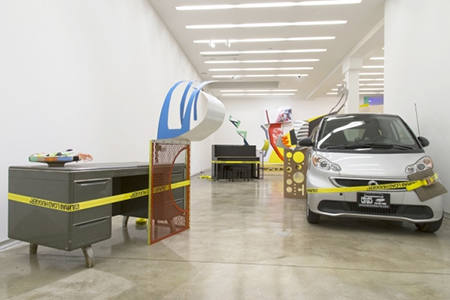
Continuing through January 16, 2016
Jessica Stockholder’s practice is one that has come to exert a significant influence. Local MFA shows and young galleries are often occupied by artists borrowing, referencing and building off of her bricolage-style sculptural installations. Sourcing materials from everyday life, Stockholder combines plastics, mirrors, appliances, corrugated aluminum, furniture and painted surfaces to create colorful, multi-dimensional abstractions. While plenty of artists have the chops to mimic her works in a modest scale, nobody does take it to monumental scale like Stockholder. Here, in “Door Hinges,” viewers see Stockholder at her best with the gallery’s cavernous space filled floor-to-lofty-ceiling with vibrant, precarious pieces.
One of the sensations that Stockholder most powerfully instills is the awareness of one’s bodily proximity to her artworks, a sensation that here begins out on the sidewalk before even entering the gallery. Posted high above the door is a swatch of color and a domed mirror not unlike the kind you’d find in an old convenience store, reflecting the multiple angles back to the clerk’s single vantage point. When Stockholder does it, it’s not about surveillance, but the attention to one’s self. Inside, viewers are continually confronted with their reflections, through mirrors and other glossy surfaces — even the windows of an actual Smart car parked in the gallery.
Our physical presence also comes into play in works that question the use and function of the appropriated vernacular objects. “In Many Places” includes one of those convex mirrors adorned with colorful foam hangs above an empty stool. A raised, wooden platform encircles the room. “Assist 2” and “Assist 3” feature a desk and piano, respectively, at which no one can sit, as yellow cargo straps bind to them painted steel grates and arched metal sheets. An enormous chest freezer covered in paint and decals is affixed to the wall high above our heads, beckoning us to stand beneath it and experience the full effects of its tension. While the painted freezer seems destined for a life as art, the carefully parked Smart car of “Assist 1” makes one wonder whether the vehicle might go back to the dealership to resume a conventional existence.
Upstairs from Stockholder’s solo exhibition is “ASSISTED,” a group exhibition of 16 other artists that she has curated. Like the downstairs show, the upstairs is a commingling of found objects, paintings and installation works that are arranged close enough to one another to reference the spontaneous, free-form placement that Stockholder employs in her own practice. Considered individually, Anthony Caro’s rusted steel objects and Nancy Lupo’s kitty-litter encrusted wire racks share little if anything in common with what we normally associate with these artists' imagery. Alternately, pieces like the whip-smart word play of Kay Rosen’s “RUST COLORED BELT” wall text and the flattened space and floating forms of Rebecca Morris’ untitled oil on canvas flaunt the signature styles of their makers. Are the works in “ASSISTED” thematically related, autonomous pieces in close proximity? Or are they a kind of massive collaboration with Stockholder at the helm? In both exhibitions, function, authorship and art are brought to a halt and being is fluid. The questions raised by Stockholder are simple and straightforward, but the way she goes about challenging them is massive, bold and vigorous.
